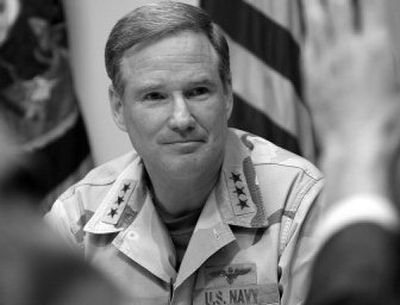Admiral defends Gulf buildup

MANAMA, Bahrain – Iran has brought its war games maneuvers over the past year into busy shipping lanes in the Straits of Hormuz, the narrow mouth of the Persian Gulf through which two-fifths of the world’s oil supplies pass, the top U.S. Navy commander in the Mideast said.
The moves have alarmed U.S. officials about possible accidental confrontations, and led to a recent buildup of Navy forces in the Gulf, Vice Adm. Patrick Walsh said. During maneuvers, Iranian sailors have loaded mines onto small mine-laying boats and test-fired a Shahab-3 ballistic missile into international waters, he said.
“The Shahab-3 most recently went into waters very close to the traffic separation scheme in the straits themselves. This gives us concern because innocent passage of vessels now is threatened,” Walsh said on the base of the Navy’s Fifth Fleet in the Gulf island kingdom of Bahrain.
Iran tested the Shahab-3 during November maneuvers, which it said were in response to “adventurist” U.S. maneuvers in the Gulf. Iran also showed off an array of new torpedoes in war games in April.
The carrier USS John C. Stennis – backed by a strike group with more than 6,500 sailors and Marines and with additional minesweeping ships – arrived in the region Monday. It joined the carrier USS Dwight D. Eisenhower after President Bush ordered the buildup as a show of strength to Iran.
The additional U.S. firepower has ratcheted up tensions with Iran, but Walsh said the increase aims to reassure Arab allies in the Gulf and prevent misunderstandings that could escalate into outright conflict.
“That’s certainly what we’re trying to avoid, a mistake that then boils over into a war,” said Walsh, who departs his command of the Fifth Fleet this month to become vice chief of naval operations at the Pentagon, the Navy’s No. 2 post.
Walsh said the Navy was responding to “more instability than we’ve seen in years” in the Fifth Fleet’s region – with conflicts in Iraq, Afghanistan and Somalia, tensions in Lebanon and the standoff with Iran.
The Navy has grown increasingly alarmed at what Walsh called Iran’s “provocations.” Once cordial Navy ship-to-ship relations with Iran in the Gulf have disintegrated over the past 18 months as Iranian vessels made “probing” incursions into Iraqi waters, he said.
“They threaten to use oil as a weapon. They threaten to close the Straits of Hormuz,” Walsh said. “And so it is the combination of the rhetoric, the tone, and the aggressive exercises in very constrained waters that gives us concern.”
Since the Stennis was ordered to the region, Iranian leaders have increasingly warned that they would respond to any attack by closing off oil shipping lanes or attacking U.S. interests.
The Straits of Hormuz are 34 miles across, but its shipping lanes are only about six miles wide.